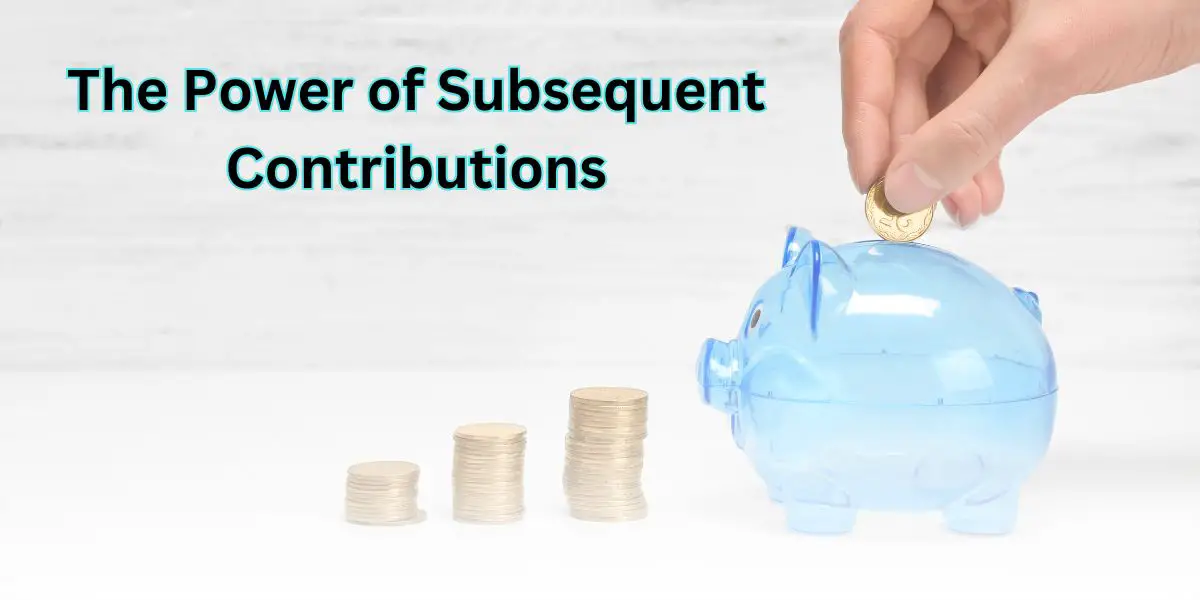In today’s financial landscape, individuals are increasingly looking for ways to secure their financial future. One such strategy gaining popularity is subsequent contribution, also known as regular investment. This approach involves making consistent, periodic investments into an investment vehicle over time.
This article explores the concept of subsequent contributions, how it works, its benefits, and considerations before making such investments.
Understanding Subsequent Contribution
- Definition: Subsequent contribution refers to the practice of regularly investing a fixed or variable amount of money into an investment vehicle over time. This can be done weekly, monthly, or quarterly, depending on the investor’s preference.
- Importance: Subsequent contributions help investors build wealth gradually over time by taking advantage of compounding returns and dollar-cost averaging.
How Subsequent Contribution Works
When an investor makes subsequent contributions, they are buying more shares of an investment at different price points. This helps reduce the impact of market volatility on their overall investment portfolio.
Benefits of Regular Investment
- Dollar-Cost Averaging: Subsequent contributions allow investors to buy more shares when prices are low and fewer shares when prices are high, resulting in a lower average cost per share over time.
- Compounding Returns: Regular investments enable investors to benefit from compounding returns, where the earnings on their investments generate additional earnings.
- Risk Management: By spreading investments over time, investors can reduce the risk of investing a large sum of money at the wrong time, such as during a market downturn.
Factors to Consider Before Making Subsequent Contributions
Before committing to regular investments, investors should consider their financial goals, risk tolerance, and investment horizon. It’s essential to align subsequent contributions with these factors to ensure they meet their objectives.
How to Make Subsequent Contributions
Investors can make subsequent contributions through automatic investment plans, where a fixed amount is deducted from their account regularly. Alternatively, they can manually contribute funds to their investment accounts.
Also Read: What is Thrift and Credit Society?
Examples of Subsequent Contribution Strategies
One common strategy is to invest a fixed percentage of income regularly. Another approach is to invest a specific amount of money each month, regardless of market conditions.
Tips for Maximizing Subsequent Contributions
To maximize subsequent contributions, investors should focus on consistent investing, regularly rebalancing their portfolio, and staying informed about market trends.
Risks Associated with Subsequent Contributions
While subsequent contributions offer many benefits, they are not without risks. Market volatility and liquidity risks are two key factors that investors should consider before making regular investments.
In conclusion, subsequent contribution is a powerful strategy for building wealth over time. By understanding how it works, its benefits, and risks, investors can make informed decisions to secure their financial future.
Also Read: How to Claim Auto Insurance in Allentown 2024
FAQs
- Is subsequent contribution suitable for all investors?
- Subsequent contribution can be suitable for investors with long-term financial goals and a tolerance for market fluctuations.
- What are the tax implications of regular investments?
- Tax implications vary depending on the investment vehicle and the investor’s jurisdiction. It’s advisable to consult with a tax professional.
- Can I stop subsequent contributions at any time?
- Yes, investors can stop or modify subsequent contributions at any time, depending on the investment plan.
- Are there any penalties for missing a subsequent contribution?
- Penalties may apply depending on the investment vehicle and the terms of the investment agreement.
- How often should I review my subsequent contribution strategy?
- It’s advisable to review your strategy regularly, at least annually, to ensure it aligns with your financial goals and market conditions.
Maximizing Your Roth IRA Contributions: A Comprehensive article
Unlocking Wealth: The Power Play of HDFC Multi Cap Fund for Maximum Returns!



